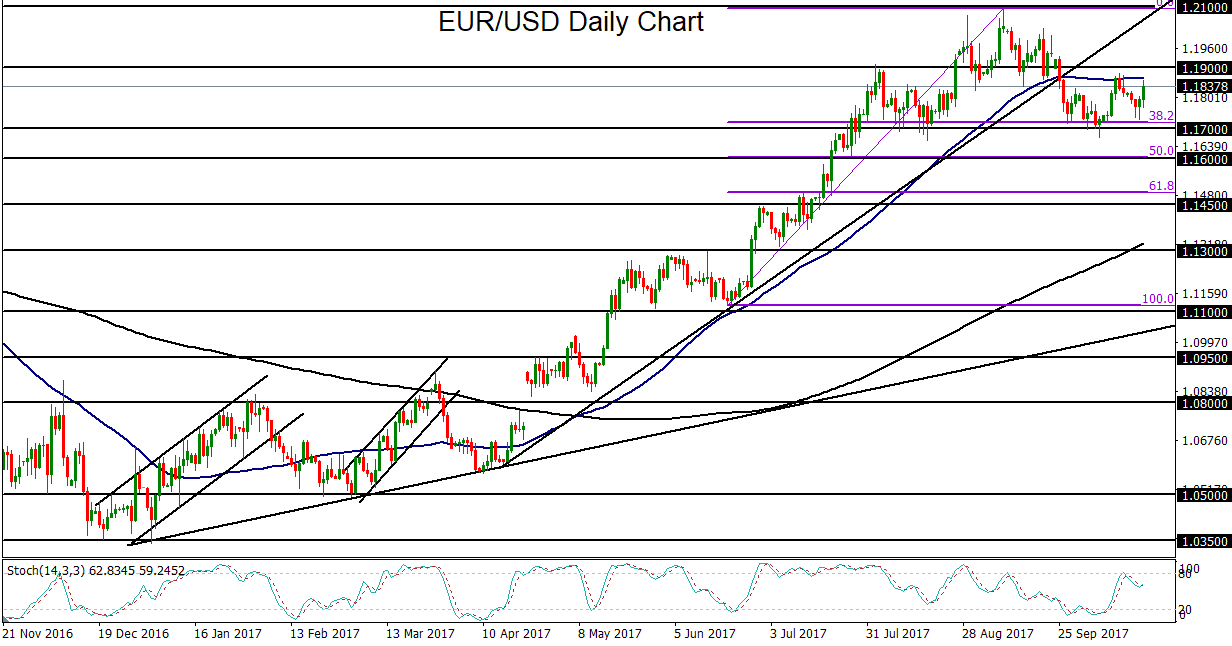Despite recent geopolitical risks in Europe posing potential threats to the euro, the common currency has managed to remain relatively resilient against its major counterparts, including the US dollar and Japanese yen. Most recently, a tense stalemate between Spain’s central government and the Catalonia region’s independence movement has also failed thus far in making any substantially negative impact on the euro.
The key upcoming event that could make a significant impact, whether positive or negative, will be the European Central Bank’s (ECB) policy decision and press conference set for a week from now, on Thursday of next week. Prior to that ECB meeting, key services and manufacturing PMI data for France, Germany, and the Eurozone as a whole, will be released on Tuesday.
Although an interest rate increase is certainly not expected from the ECB next week, euro traders will be paying extremely close attention to any indications by ECB President Mario Draghi of the central bank’s plans to taper its monthly asset purchases. Most expect the ECB to announce that it will begin reducing those purchases starting in January, down from the current €60 billion/month. The key questions remain, however, as to the specific magnitude of that reduction as well as the planned duration of the asset purchase program. The ECB will likely be wary about sounding too hawkish or aggressive in its tapering plans, as any such talk or action would undesirably exacerbate euro strength.
Ahead of this pivotal ECB decision, the euro, as noted, has remained resilient even in the face of significant geopolitical concerns. The euro has generally been trading in a range against the US dollar for the past three weeks, after the EUR/USD currency pair broke down in late September below a key uptrend line that has been in place since April. Currently, EUR/USD is trading just under its 50-day moving average and between key price levels around the 1.1700 support area to the downside and the 1.1900 resistance area to the upside. The ECB decision next week will help dictate if and in what direction the euro may break this trading range. A likely scenario is that the central bank may advocate a more gradual tapering process over a longer period of time than expected, in part to avoid further euro strengthening. If this is the case, the euro could take a hit and EUR/USD could stumble, especially if Fed-driven dollar support resumes. In this event, a EUR/USD breakdown below 1.1700-area support could pressure the currency pair towards key downside targets around the 1.1600 and 1.1450 support areas.
Investopedia does not provide individual or customized legal, tax, or investment services. Since each individual’s situation is unique, a qualified professional should be consulted before making financial decisions. Investopedia makes no guarantees as to the accuracy, thoroughness or quality of the information, which is provided on an “AS-IS” and “AS AVAILABLE” basis at User’s sole risk. The information and investment strategies provided by Investopedia are neither comprehensive nor appropriate for every individual. Some of the information is relevant only in Canada or the U.S., and may not be relevant to or compliant with the laws, regulations or other legal requirements of other countries. It is your responsibility to determine whether, how and to what extent your intended use of the information and services will be technically and legally possible in the areas of the world where you intend to use them. You are advised to verify any information before using it for any personal, financial or business purpose. In addition, the opinions and views expressed in any article on Investopedia are solely those of the author(s) of the article and do not reflect the opinions of Investopedia or its management. The website content and services may be modified at any time by us, without advance notice or reason, and Investopedia shall have no obligation to notify you of any corrections or changes to any website content. All content provided by Investopedia, including articles, charts, data, artwork, logos, graphics, photographs, animation, videos, website design and architecture, audio clips and environments (collectively the "Content"), is the property of Investopedia and is protected by national and international copyright laws. Apart from the licensed rights, website users may not reproduce, publish, translate, merge, sell, distribute, modify or create a derivative work of, the Content, or incorporate the Content in any database or other website, in whole or in part. Copyright © 2010 Investopedia US, a division of ValueClick, Inc. All Rights Reserved
Recommended Content
Editors’ Picks
AUD/USD could extend the recovery to 0.6500 and above

The enhanced risk appetite and the weakening of the Greenback enabled AUD/USD to build on the promising start to the week and trade closer to the key barrier at 0.6500 the figure ahead of key inflation figures in Australia.
EUR/USD now refocuses on the 200-day SMA

EUR/USD extended its positive momentum and rose above the 1.0700 yardstick, driven by the intense PMI-led retracement in the US Dollar as well as a prevailing risk-friendly environment in the FX universe.
Gold struggles around $2,325 despite broad US Dollar’s weakness

Gold reversed its direction and rose to the $2,320 area, erasing a large portion of its daily losses in the process. The benchmark 10-year US Treasury bond yield stays in the red below 4.6% following the weak US PMI data and supports XAU/USD.
Bitcoin price makes run for previous cycle highs as Morgan Stanley pushes BTC ETF exposure

Bitcoin (BTC) price strength continues to grow, three days after the fourth halving. Optimism continues to abound in the market as Bitcoiners envision a reclamation of previous cycle highs.
US versus the Eurozone: Inflation divergence causes monetary desynchronization

Historically there is a very close correlation between changes in US Treasury yields and German Bund yields. This is relevant at the current juncture, considering that the recent hawkish twist in the tone of the Federal Reserve might continue to push US long-term interest rates higher and put upward pressure on bond yields in the Eurozone.
